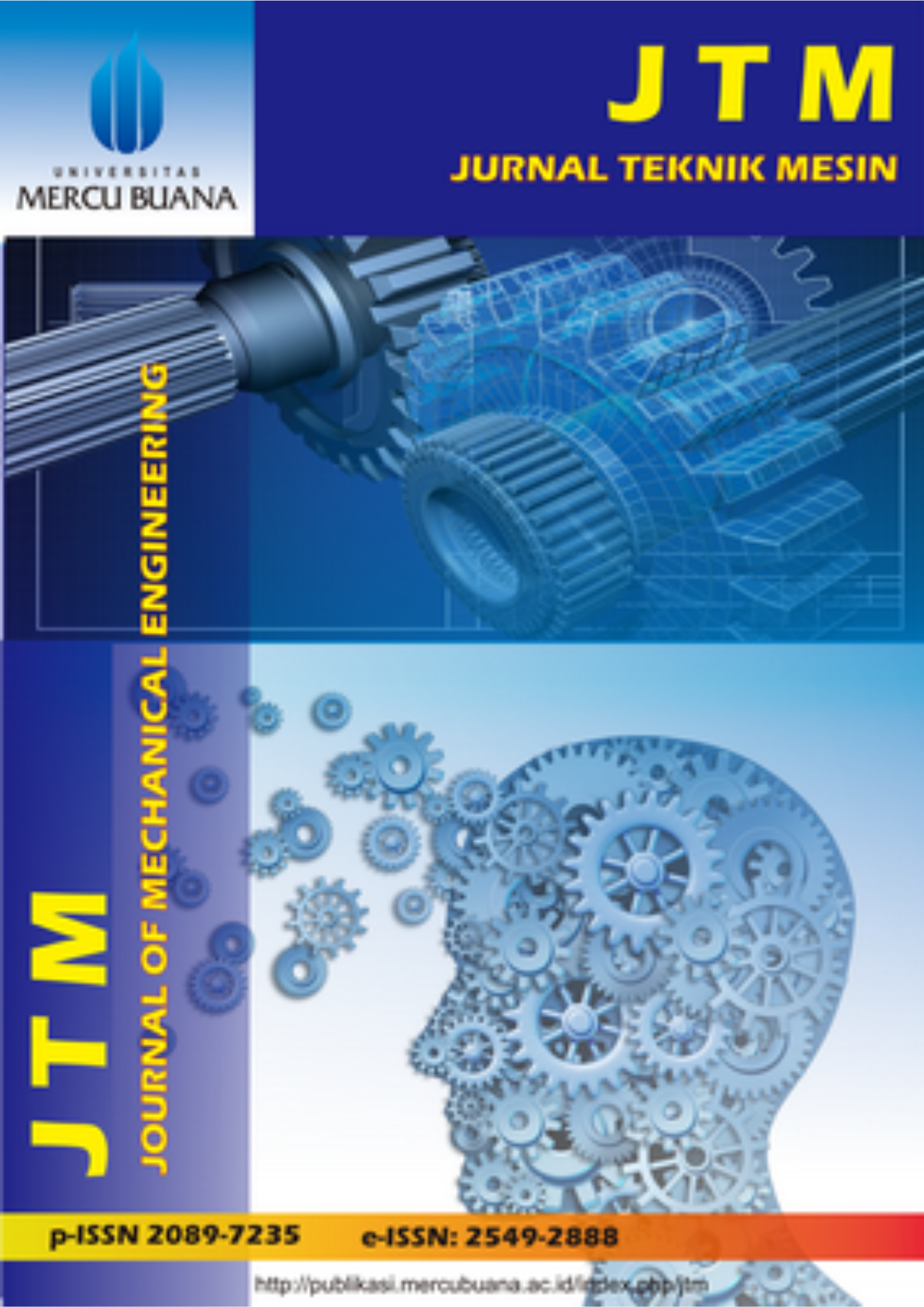ANALISIS EFISIENSI PROSES PRODUKSI PADA MESIN METAL SHEET PRINT TIPE MS2 DALAM PRODUKSI KEMASAN KALENG DENGAN METODE TPM DAN SMED
Abstract
Abstrak -- Mesin metal sheet print type MS2 memiliki peran besar dalam proses pembuatan kaleng, yaitu dalam proses printed sheet. Pada bulan Januari 2022 diperoleh bahwa nilai OEE sebesar 39,76% dimana nilai Avaibility rate nya 47,49%, Performance rate senilai 84,91% dan nilai Quality rate 98.68%. Sedangkan nilai kerugian terbesar dihitung dengan six big losses terjadi pada avaibility losses yakni dengan total losses sebesar 50% yang terdiri dari breakdown losses (BL) 14% dan setup and adjusment losses (SAL) 36%. Berdasarkan diketahui nya losees pada setup and adjusment losses (SAL) saat change over C/O, start up dan downtime mesin maka dilakukan penerapan metode SMED untuk menurunkan nilai downtime yang terjadi pada mesin saat startup. Dan metode TPM digunakan untuk menaikan nilai avaibility dan quality, hasilnya mampu meningkatkan avaibility rate sebesar 4.41% dengan mengurangi waktu Changeover (C/O) sebesar 45 menit sehingga menghasilkan nilai rata-rata OEE menjadi 43.12%
Abstract-- The MS2 type sheet metal print machine has a big role in the process of making cans, namely in the printed sheet process. In January 2022, it was found that the OEE value was 39.76% where the Avaibility rate value was 47.49%, the Performance rate was 84.91% and the Quality rate was 98.68%. Meanwhile, the largest loss value is calculated using six big losses, which occur in availability losses, namely with a total loss of 50% consisting of breakdown losses (BL) 14% and setup and adjustment losses (SAL) 36%. Based on the known losses in setup and adjustment losses (SAL) during change over C/O, start up and engine downtime, the SMED method is applied to reduce the downtime value that occurs on the engine at startup. And the TPM method is used to increase the value of availability and quality, the result was able to increase the availability rate by 4.41% by reducing the Changeover time (C/O) by 45 minutes so that the average OEE value became 43.12%.
Keywords
Full Text:
PDF (Bahasa Indonesia)References
Kumat,Amir, et al. (2015).Overall Equipment Effectiveness Improving of Piston Machining Line using SMED and DOE. International Journal of Innovative Research in Service,Engineering and Technology.Vol 4,issue 6.
Kumar, Tilkar,Asim. (2013). A case study approach to productivity enchancement and calculation of Overall Equipment Effectiveness.International Journal of Emerging Trends in Engineering and Development. Issue3,Vol 1.
James,Ted. (2011). Oprations Strategy.Bookboon.com. ISBN 978-87-7681-828-9.
Shinhal,A,. dan Ankur, K. (2016). Overall Equipment Effectiveness improvment by reducing Non value-adding Activities using Lean Tools. IJARIIE-ISSN(O)-2395-4396. Vol-2issue3.
Boban,Binoy., dan Jenson, Joseph E. (2013). Enchancing Overall Equipment Effectiveness for a Manufacturing Firm Through Total Productive maintenance.International journal of Emerging Technology and Adcanced Engineering.Volume 3, Issue 8.
Saini,Gaurav,. dan ER.Harvinder Lal. (2016). Aplication of SMED Programme of lean Manufacturing for improving overall equipment efficiency-A Case Study.International jurnal on Emerging Technologi 7(2):33-35.
Shingo,S. (1985). A revolution in manufacturing : the SMED system. Camridge, MA: Productivity Press
Ramiz,Assaf,. dan Tamer, Haddad. (2014). Performance Improvement Using the Single Minutes of Die(SMED) Methodology in an Aluminum Profiles Extrusion Production System.The 1st InternationalConference on industri,Systems and manufacturing Engineering (ISME’14).
Sivaselvam.E,. dan S. Ganjendran. (2014).Improvement of Overall Equipment Effectiveness In a Plastic Injection Moulding Industry.IO
Vivekananda,T,. dan S. Appaiah. (2016). ImprovementOf Overall Equipment Effectiveness Of Press Machine using Lean Concepts. International Journal for technological Reasearch In engineering. Vol3-Issue 10.
DOI: http://dx.doi.org/10.22441/jtm.v12i3.15930
Refbacks
- There are currently no refbacks.
Copyright (c) 2023 Jurnal Teknik Mesin
Jurnal Teknik Mesin (JTM)
Program Studi Teknik Mesin, Fakultas Teknik, Universitas Mercu Buana
Jl. Meruya Selatan No. 01, Kembangan, Jakarta Barat 11650, Indonesia
Email: [email protected]
Telp.: 021-5840815/ 021-5840816 (Hunting)
Fax.: 021-5871335
JTM is indexed by the following abstracting and indexing services:

This work is licensed under a Creative Commons Attribution-NonCommercial 4.0 International License.






.png)







_(486_x_90_px)_(486_x_190_px)_(486_x_190_px)_(4).png)
_(486_x_90_px)_(486_x_190_px)_(486_x_190_px)_(5).png)
2.png)
.png)